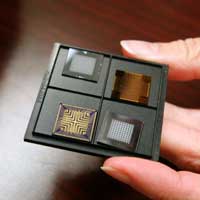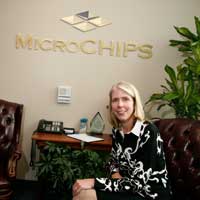MicroCHIPS Inc. may have been the result of divine inspiration (as the story goes, MIT professor Robert Langer thought of the idea while watching PBS), but it took people like Maggie Pax to turn his vision into a suite of implantable devices that could one day revolutionize medicine.
Pax, the VP of business development for MicroCHIPS, has been at the Bedford, Mass.-based implantable drug delivery company since 2006. She’s charged with figuring out a way to get the best return on investment from the company’s technology platform. Through targeted partnerships with larger firms and carefully vetting which markets to enter, Pax says MicroCHIPS has leveraged its intellectual property, technology platform and talent pool to play in several arenas at once. She says that’s the best way to mitigate risk in an inherently risky business.
It’s also the theme of the keynote address she’ll give Oct. 27 at the Medical Product Outsourcing Symposium. The annual symposium, put on by the eponymous New Jersey-based trade publication, will take place in Waltham and run through Oct. 28. The theme this year is “Mitigating Risk Throughout the Outsourcing Process: Today’s Most Critical Manufacturing Decisions for Medical Device Companies.” (Eds. note: MassDevice readers can save $400 off the registration price by using the code MASSDEV.)
MassDevice sat down with Pax recently to discuss her speech and to find out what’s happening at MicroCHIPS:
Photos and audio slideshow by Connor Gleason
MassDevice: You’re the keynote speaker at the MPO Symposium next week. Can you give us a little preview of your remarks?
Maggie Pax: The medtech field is inherently risky, so the areas I’m going to talk about include clinical risk, which is when you go into a clinical trial and things don’t turn out the way you expected; I’m also going to talk about market acceptance risk, so even once you’ve gotten approval your customer base still has to see a lot of value in your approach; and the third type of risk is business and finance risk, which is top-of-mind for a lot of companies right now.
The pain that the medtech and sciences field is feeling right now is over the financial crunch, so access to capital in its most basic sense is challenging, but I would argue that it’s always challenging. It’s more challenging now and there are more good companies, that have good ideas and have good progress, that have not been able to find financing, but it’s always a little bit Darwinian. It’s just a little more Darwinian right now. The point of the first part of my talk is to say that there are certain points along the path of being successful where there’s increased risk; one of them is in clinical trials; one of them is market acceptance; and then there’s always risk in financing.
I’ll talk about these areas and show some examples and case studies for how companies have encountered these risks. And I’ll talk about different ways that you can mitigate these risks. The first part will looking at these companies and how these things have turned out to be very challenging. The second part will be some practical thoughts on how companies can mitigate risk.
MassDevice: Will you use examples from your career?
MP: I’ll use mostly examples from the industry, pretty specific examples of how companies have tried to minimize risks. On the risk mitigation part, I’ll talk about Philips Healthcare, which is a previous company of mine. Philips is a very broad-based company and the way they’ve managed risk is to be able to bulk up with a lot of products and acquisitions that can balance each other when one field is not doing well. They’ve done a lot of acquisitions in home healthcare in the last several years, in part because it’s a nice offset to their hospital-based  businesses and some of the risks that you have in selling into a hospital environment.
businesses and some of the risks that you have in selling into a hospital environment.
The example I’ll give about MicroCHIPS is, even with a small company, we’ve been able to mitigate risk by doing more than one program and more than one clinical area at a time, and initiating several creative partnerships. So the partnerships that we’ve been able to do go all the way from traditional equity investment, to joint ventures, to funded R&D.
MassDevice: Specifically, how has MicroCHIPS has used partnerships to mitigate risk?
MP: Small companies can creatively broaden their portfolios, knowing that if you broaden your portfolio too much as a small company you can lose focus and not achieve your objectives. For a company like us, there’s a couple moves we’re doing. One is organic product development, which is products we’re developing ourselves. In that regard we have two programs we’re running internally ourselves and we’re leveraging our technology from one to the other.
Our two programs make use of the same underlying platform technology, which involves the ability to create wireless devices that can protect and release a drug, or protect and expose a sensor. These are long-life devices that will be able to live in the body and monitor what’s going on with that patient and also deliver therapy.
MassDevice: From reading early literature on the company, it seems that MicroCHIPS was originally designed to be solely a drug-delivery company. Was the development of a diagnostic product always part of the game plan, or was it developed through analysis of markets and potential?
MP: It’s true the earlier publications have been in the drug delivery field, but the idea of using an array of reservoirs to protect chemical sensors is in the very earliest IP, so it was definitely there as a concept.
But it’s true that if you go through development and you see  an opportunity to create a new product, we look at that all the time. We evaluate those opportunities and try to figure out, “Are they something we can fund ourselves doing these programs?” Or, “Is it something where we can find a partner who can either provide funding or license the IP and run with it on their own?”
an opportunity to create a new product, we look at that all the time. We evaluate those opportunities and try to figure out, “Are they something we can fund ourselves doing these programs?” Or, “Is it something where we can find a partner who can either provide funding or license the IP and run with it on their own?”
So while we have two products that we’re developing internally, we also have external relationships that allow more ways to exploit the platform beyond areas that we can do beyond our four walls. For a company with a broad range of intellectual property, we can do that partnering. We’re not a one-product company, we’re truly a platform company.
MassDevice: How do you target partners and how do you vet them? Is there a simple formula, or a standard measure?
MP: Well, sometimes we’re lucky enough that partners target us. In a way that’s ideal, because if they’ve looked at what we’re doing and they understand our value and they come to us, then it’s a lot easier to come to an agreement on partnership.
But when we target partners, we have a pretty good process for doing our own diligence on what the application should be, by looking at the markets, the clinical value, our ability to make a technology difference. We winnow [many opportunities] down to a couple that we want to pursue and we identify who some of the bigger companies are in that market or the small companies that would be great partners. I think we’ve been very successful because our current partners are pretty high-profile.
MassDevice: You’ve been with MicroCHIPS since 2006. Tell us about the development of the company from your vantage point. What were your original marching orders and how have they changed over the years?
MP: There has been a change. When I first came in the company had matured the technology to the point where it was possible to start thinking of the products that we could develop. Part of my role then was to determine where we ought to go for our initial targets, which products should we be developing, what the value would be in developing a diabetes product and an osteoporosis product.
As we’ve moved along and made progress, I now have other responsibilities for the clinical and regulatory areas because we’re heading toward our human studies. Knowing how we’re going to execute on those studies is very critical to our planning and very important to our partnerships in getting to that next value inflection point.
MassDevice: Tell us why you focused on the glucose monitoring market first.
MP: There’s a fundamental thing in that both diabetes and osteoporosis are very wide-spread. In the diabetes field, insulin delivery has been refined to the point where there are new kinds of pumps and painless needle injections, but the really weak spot in that field is having a reliable, long-term sensing technology, something that could really last a long time and not have the person with diabetes have to be changing it out and fiddling with the device. A lot of companies have tried to do that, to create a device that would give you a long-lived signal.
But without the ability to protect a glucose sensor it degrades, so a lot of companies were not able to overcome that fundamental biological risk. We understand the body will attack a sensor over time, so we’re creating a redundant array of sensors that can be used sequentially. They’re hermetically sealed, so you can open one and when that one has lost its sensitivity move on to the next sensor. It’s a very an elegant way to create a long-lived device, using an array of sensors instead of just one.
The same thing is true for parathyroid hormone. The trouble with the PTH for osteoporosis, which is our program, the trouble in that field is that you won’t get people to comply with the daily injection. Usually you’re talking about a 70-year-old woman who is  supposed to do a daily injection of a drug and do it just right for a year or a year and a half, and it if they aren’t able to accomplish that because they forget they’re really at risk for a broken bone.
supposed to do a daily injection of a drug and do it just right for a year or a year and a half, and it if they aren’t able to accomplish that because they forget they’re really at risk for a broken bone.
So our theory right there is to say, “We can use a series of reservoirs, each one of which can give a daily dose, and then we can create a device that will be the entire course of therapy that won’t require the patient to take the drug, or do the injection every day.”
Either one of these devices would be implanted subcutaneously, using local anesthetic in an outpatient setting. We’re targeting long-lived devices that are equipped to last a year in the body. They do have wireless technology, so you can get a signal out and connect to the device. We have the ability to find out what your glucose is, or we can change the dosing regimen if that’s what you’re going to do, so the ability to take the chemical therapy, the monitoring and the wireless communication, I think it’s pretty novel to put those three things together.
MassDevice: Is there a theme between those two areas that made them the right markets at the right time for MicroCHIPS? Was it mostly demographics?
MP: The demographics were part of it, but you can see electronics and wireless connectivity maturing to the point where we can take advantage of the fact that people really want to be connected and know what’s going on with an elderly person, or be able to transmit medical information.
The maturity of that issue is really important, because there have to be standards, there has to be security. We’re increasingly seeing those things get a lot more attention, because everyone wants to reduce costs.
At the same time, one of the things we bring to the table is, on the drug side, we can do very stable concentrations of proteins and peptides. The other thing is that in the biotech world many of the most powerful drugs now are large molecules, they’re proteins or peptides, which you can’t typically take as a pill. So we’re very well-poised because we have a formulation team that can work with those larger molecules.
On the sensing side, we also bring the protection of one of those sensors and that hasn’t been possible yet. There’s themes in wireless as to why it’s a good time and there’s themes in the bio-pharma world as well. The device construction as well is what puts us in a good position with the diabetes program.
MassDevice: How big is the company now?
MP: We’re 20 people.
MassDevice: It sounds so much bigger to hear you talk about it.
MP: Well, we think pretty big, but part of it is with partners we’re able to get a lot more done than we could with just 20 people.
MassDevice: MicroCHIPS has some very notable names and institutions behind it. Do you feel any extra pressure to over-deliver? Is there pressure that this company can’t just be successful, it has to be revolutionary?
MP: I don’t think there’s any such thing as over-delivering, I really don’t. I think this company was founded and still is targeting revolutionizing the way medicine is delivered. We’re not a one-product company and we’re not limited to a narrow value-add. We want to capitalize on the ability to do a lot. I think the expectations are very high, but they’re merited. We feel constant pressure, but that’s why we’re here. We want to be part of something big and I wouldn’t have it any other way.

